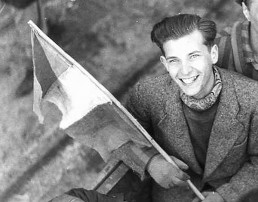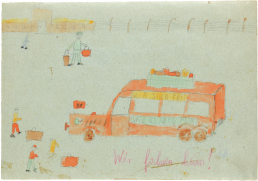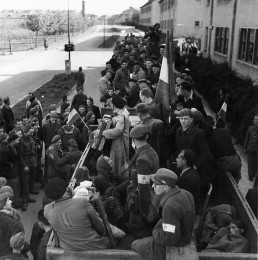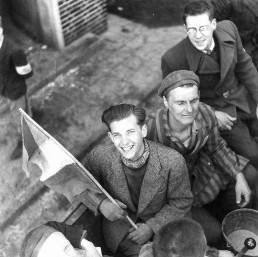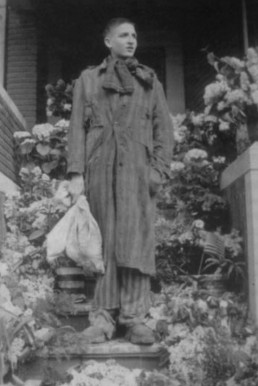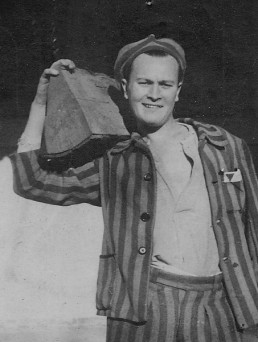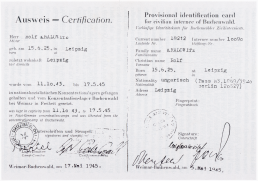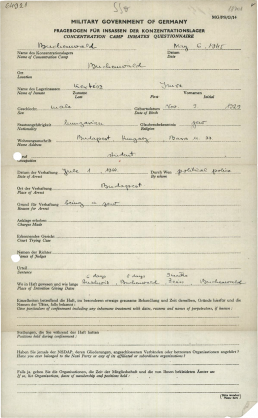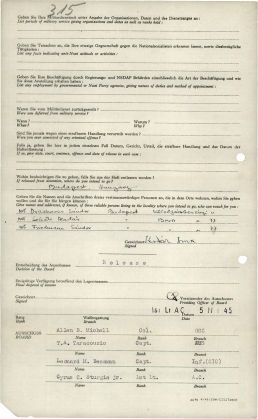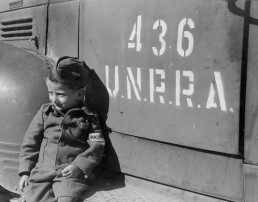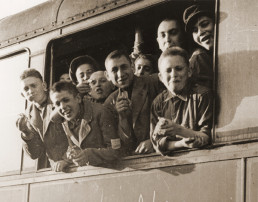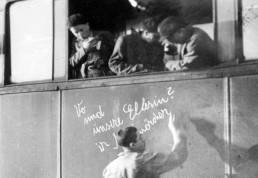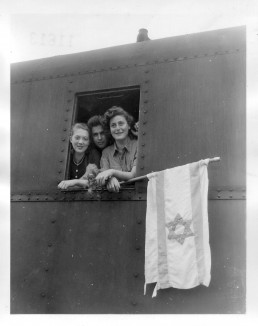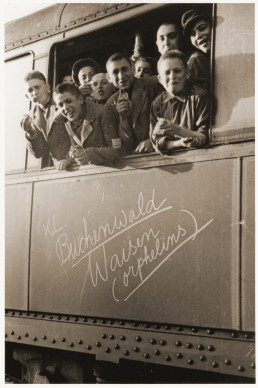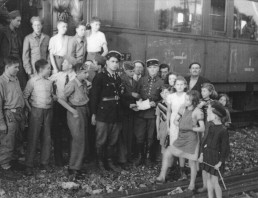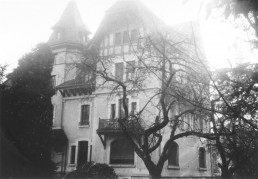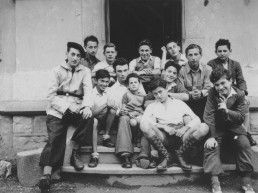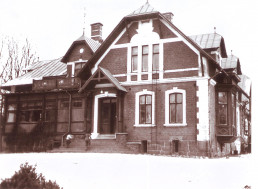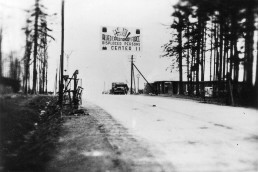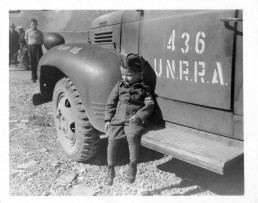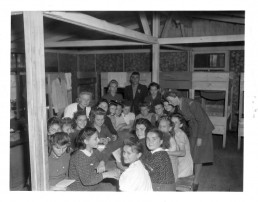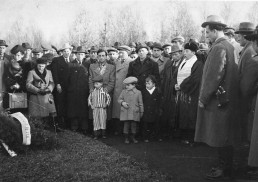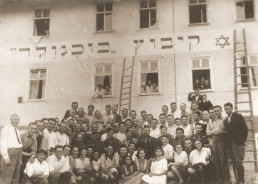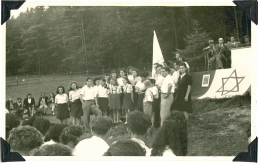Return home
After liberation
The liberated children and adolescents wanted nothing more than to return home to their families. For many survivors, however, that was impossible. Jewish survivors had often lost all their relatives in the Holocaust, and their hometowns had been obliterated. Reports of pogroms in Poland and Eastern Europe discouraged people from returning.
Many of the children and young people did not know where their relatives were or whether they were still alive. The Allies and aid organizations such as the Red Cross helped to reunite families.
Those who were able to return home the quickest were the young people from Western Europe who had been deported to the camps as political prisoners. Many were back with their families by early May 1945. They were considered heroes of the Résistance and were received with public honors in their home communities.
"By mid-May [1945], most of the prisoners whose health had been restored had left for their home countries. But there were exceptions: the Spaniards whom Franco had turned over to the Nazis preferred to remain in exile rather than return to a country still in the hands of a dictator. Many of the Poles were uncertain about the policies and new borders of their reborn state and therefore wanted to wait for further developments. Surviving Jews from Poland, Hungary and Romania feared returning to countries whose recent past had been marked by the horrific consequences of anti-Semitism."
Thomas Geve on the problems of returning home after liberation, 2000.
In his autobiographical account, Thomas Geve describes the impossibilities of returning home, especially for Eastern European Jews.
(Thomas Geve, Aufbrüche. Weiterleben nach Auschwitz, Constance 2000)
Western European prisoners leaving Bergen-Hohne barracks by truck, 25 April 1945.
In April 1945, evacuation transports from Mittelbau-Dora were sent to the Bergen-Hohne barracks, part of the Bergen-Belsen Concentration Camp complex. British troops liberated the survivors on 15 April 1945. Ten days later, the first liberated prisoners from France, Belgium and the Netherlands were able to return home.
(IWM)
Roger De Coster on the day after his return to his hometown near Antwerp, 29 April 1945.
Roger De Coster was deported in 1944 at the age of 16 as a political prisoner to Buchenwald and from there to Mittelbau-Dora, together with his older brothers and his father. He was one of the liberated prisoners who started their return journey home from Bergen-Hohne on 25 April 1945. The day after his return home, he had himself photographed with numerous bouquets of flowers that had been presented to him on his return.
(Private property De Coster family)
"Saturday we were welcomed everywhere in Belgium. We arrived in Mol about four o'clock in the afternoon, where they took very good care of us. I left there with the Persoons family, who had come to pick up Jules Persoons, and arrived home around midnight, where everyone was waiting impatiently for Daddy, Willy, François, and me. The reunion was, of course, very emotional for me, and it was very joyful. I asked about Daddy and Willy [...]. Eight days later, I learned that my father had died on May 2 in a hospital in Weimar. François was still alive. He arrived in Paris and was home on June 9. I was the first from my village to return, but eight days later I got typhoid fever and just barely escaped death. Fortunately, after a few weeks I was back on my feet and a new life began for me."
Roger De Coster's account of his return home on 28 April 1945, c. 1991.
(François and Roger De Coster, Van Breendonk naar Ellrich-Dora, Berchem 2006).
Return of a Nacht-und-Nebel prisoner. Charles Brusselairs in prisoner's clothing after liberation, 1945/46.
Charles Brusselairs was arrested in 1943 at the age of 18 for resisting the German occupiers in Belgium. He was deported to Germany on the basis of the clandestine Nacht-und-Nebel-Erlass (Night-and-Fog directive). After spending time in various prisons, he arrived at Buchenwald in February 1945. The SS drove him on a death march to Theresienstadt in early April. There, he was liberated four weeks later by Soviet soldiers. After months in sanatoriums, he returned to his family in Belgium in 1946.
(Private property)
Rolf Kralovitz’ provisional identity card, 5 and 17 May 1945.
The US Army issued Rolf Kralovitz a provisional identity card in Buchenwald. On 17 May 17, he was officially released and could return to his hometown of Leipzig. The document also noted the time of his imprisonment in the Buchenwald Concentration Camp.
(Estate of Rolf Kralovitz)
Questionnaire for concentration camp prisoners, filled out by Imre Kertész, 6 May 1945.
Imre Kerstész was born in Budapest (Hungary) in 1929. In July 1944, the police arrested him, and he was deported to Buchenwald via Auschwitz. After his liberation by the US Army, he filled out a questionnaire. As the reason for his imprisonment, he succinctly noted “being a Jew.” Another question asked, “Where do you intend to go if you are released from prison?” The 15-year-old entered “Budapest, Hungary”.
(Arolsen Archives)
"After a few steps I recognized our building. [...] On our floor, I rang our doorbell. [...] The door opened a crack, and a yellow, bony face of a strange middle-aged woman looked at me. She asked who I was looking for, and I said to her that I lived here. 'No,' she said, 'this is where we live,' and was about to close the door again, but she couldn't because I had put my foot in the door. I tried to explain to her that it was a mistake, because it was from here that I had left [...]."
In his story, the future Nobel laureate in Literature described his autobiographically-inspired protagonist's return home to Budapest and the conflicts it entailed, 1975.
(Imre Kertész, Fatelessness)
After liberation
Buchenwald DP camp and Kibbutz
In the course of World War II, the Germans deported several million people to the German Reich.
Children’s transports after the liberation
The parents and other relatives of the approximately 900 underage survivors of the Buchenwald Concentration Camp had almost all been murdered. Other orphans were brought to Buchenwald from…
Return home
The liberated children and adolescents wanted nothing more than to return home to their families.
Children's transports after the liberation
After liberation
The parents and other relatives of the approximately 900 underage survivors of the Buchenwald Concentration Camp had almost all been murdered. Other orphans were brought to Buchenwald from other camps after liberation. For most of them, returning to their homes was unthinkable. The Allies and international aid organizations cooperated in placing them orphanages and care homes. The organization Œuvre de secours aux enfants (OSE) played a special role. Switzerland took in 374 children and young people from Buchenwald, France took in 480, and England took in 250. Many of them wanted to emigrate to Palestine.
Most of the surviving children and adolescents from the Mittelbau-Dora Concentration Camp were liberated in Bergen-Belsen. From there, transports were organized to many countries, including Sweden.
"Where are our parents?" Children and teenagers liberated from Buchenwald at Weimar's main station on a train to Écouis (France), 1 June 1945.
Jozef Dziubak, a 17-year-old Jewish boy deported from Poland, writes in a mixture of German and Yiddish on one of the train cars, “Where are our parents? You (Nazi) murderers.” The train carried more than 400 liberated children and young people to France.
(Buchenwald Memorial)
"Orphans.” Liberated teenagers on their way to a children's home in Écouis, June 1945.
Due to the acute clothing shortage in the liberated camp, the US liberators had dressed some of the children and young people in Hitler Youth uniforms. In France, their train was attacked because they were mistaken for Nazis. The inscriptions on the wagons “K.L. Buchenwald” and “Orphans” served to protect the passengers. At one stop, the boys crowded to the window. Jacques Rybsztajn (second from left) and Arthur Fogel (bottom right) can be seen in this photo.
(United States Holocaust Memorial Museum)
Jewish teenagers with a Star of David flag before their departure from the liberated Buchenwald camp, 5 June 1945.
The two girls Yetti Halpern Beigel (left) and Martha Weber (right) were prisoners at the Bergen-Belsen Concentration Camp. After liberation, they were sent to the Buchenwald DP camp for medical treatment. Together with an unnamed youth from Latvia (center), they were photographed shortly after their departure for France. The girls planned to continue their journey to Palestine.
(Photo: James E. Myers, Buchenwald Memorial)
Arrival: At the Écouis train station, the children and teenagers are welcomed by the authorities, 5 June 1945.
After the train ride, they were welcomed by staff members of the aid organization for Jewish children, OSE. Most of the children and young people remained in France until 1947/48.
(Buchenwald Memorial)
A Swiss newsreel reports on the arrival of the "Buchenwald Children," 29 June 1945.
Rabbi Herschel Schacter accompanied the children and young people on their trip from Buchenwald to Switzerland. Among the children seen in the reel is the four-year-old Joseph Schleifstein. When the “Buchenwald children” arrived in Switzerland, the authorities and the press were surprised at the ages of some of them. The humanitarian aid operation was to have brought only children and adolescents up to 18 years of age to Switzerland, but there were also many homeless young adults who needed a perspective for the future.
(Schweizerisches Bundesarchiv)
"Buchenwald children" in Geneva, 1945/46.
The young people in the OSE homes were not only nursed back to health, they also learned trades in order to be able to build new lives for themselves. Pictured in this group photo in front of the Hôme de la Forêt in Geneva are Gert Silberbard, Gilles Segal and Norbert Bikales.
(United States Holocaust Memorial Museum)
New accommodations in Switzerland: Hôme de la Forêt in Geneva, 1945/46
The children and young people from Buchenwald who were taken in by Switzerland were housed in various orphanages and care homes. In Geneva, the Hôme de la Forêt was made available, and the relief organization OSE (Oeuvre de Secours aux Enfants) provided care.
(United States Holocaust Memorial Museum)
"It was a great effort to bring us back to life." Account by Shraga Milstein on the transport to Sweden, February 2021.
In the fall of 1944 when he was 11 years old, Shraga Milstein was deported from a forced labor camp in Poland to the Buchenwald Concentration Camp, along with his younger brother and father. His father died there, and the brothers were separated in January 1945 when Shraga was transferred to Bergen-Belsen. Both brothers survived and were taken to Sweden in the summer of 1945 with a group of other children who had survived the camps.
(Buchenwald Memorial)
After liberation
Buchenwald DP camp and Kibbutz
In the course of World War II, the Germans deported several million people to the German Reich.
Children’s transports after the liberation
The parents and other relatives of the approximately 900 underage survivors of the Buchenwald Concentration Camp had almost all been murdered. Other orphans were brought to Buchenwald from…
Return home
The liberated children and adolescents wanted nothing more than to return home to their families.
Buchenwald DP camp and Kibbutz
After liberation
In the course of World War II, the Germans deported several million people to the German Reich. After liberation, the Allies registered them as Displaced Persons (DP) and organized their return to their countries of origin. DPs were not only concentration camp survivors, but also liberated civilian forced laborers, especially from Eastern Europe.
After the war, DP camps were set up in all German occupation zones, including at the liberated Buchenwald and Mittelbau-Dora camps. For many survivors, however, repatriation was not possible, especially for the Jewish orphans. Some of them founded the Kibbutz Buchenwald in order to prepare for their joint departure to Palestine and their future life in a Jewish community.
In early July 1945, Thuringia became part of the Soviet occupation zone. The Buchenwald DP camp was transformed into a “repatriation camp” under Soviet management and was disbanded in October 1945.
Allied banner at the main entrance of the Displaced Persons Center II in Buchenwald, April/May 1945.
After the liberation of the concentration camps, about 2,000 DP camps were established in Germany, Austria and Italy. The former Buchenwald Concentration Camp served as a reception and transit camp for former prisoners and forced laborers.
(Photo: Alfred Stüber, Buchenwald Memorial)
Joseph Schleifstein on a UNRRA truck at the Buchenwald DP camp, after 11 April 1945.
The United Nations Relief and Rehabilitation Administration (UNRRA) was responsible for the DP camps and organized the repatriation of the survivors to their countries of origin. The photo of the 4-year-old concentration camp survivor Joseph Schleifstein was taken at the liberated Buchenwald camp.
(United States Holocaust Memorial Museum)
A UNRRA staff member with orphans in the Dora DP camp, 29 June 29 1945.
A DP camp was also established in the liberated Mittelbau-Dora Concentration Camp. In May 1945, more than 20,000 liberated forced laborers and several hundred concentration camp survivors were housed here. UNRRA staff took care of orphans whose parents had died as forced laborers or concentration camp prisoners.
(Photo: Edward Vetrone, Mittelbau-Dora Concentration Camp Memorial)
Commemoration ceremony organized by Jewish DPs in the liberated Buchenwald camp, June 1945.
In the Buchenwald DP camp, survivors organized many cultural events shortly after liberation. These included religious festivals and services as well as commemoration of the dead. At the center is Joseph Schleifstein wearing his striped prisoner suit.
(United States Holocaust Memorial Museum)
"Of the survivors, a considerable number will endeavor to find a new home in Palestine. After the unspeakable suffering that these people have endured, it is the duty of the Zionist public to fight to ensure that these Zionists are offered the opportunity to immigrate to Eretz Israel as soon as possible. [...] Obtain special certificates for children and young people who are still [...] in the camps and most of whom are orphans. Create for these children the possibility of a hakhshara in Western Europe, otherwise they will become dependent on public welfare when they return to their former homeland. Save the rest of the Jewish youth in Central Europe!"
"Obtain special certificates for children and youth". Appeal of the Jewish Relief Committee, 22 April 1945.
Palestine was one of the main destinations for emigration of Jewish survivors. Until the establishment of the State of Israel in May 1948, the country was still under British Mandate, and entry was strictly regulated. The Zionist movement had established so called hachsharas as early as the 1920s to offer agricultural training in preparation for emigration.
(Ghetto Fighters’ House – Beit Lochamei HaGeta’ot )
Young members of Kibbutz Buchenwald sing partisan songs outdoors at Gehringshof, summer 1946.
The Kibbutz Buchenwald at Gehringshof existed from June 1945 to October 1948. During the preparations for departure to Palestine, a variety of cultural events took place there. In 1948, the Kibbutz moved to Israel and in 1950 it changed its name to Netzer Sereni.
(Photo: David Marcus, United States Holocaust Memorial Museum)
Kibbutz Buchenwald. Group photo in front of the agricultural training center in Gehringshof, 1945.
On 3 June 1945, Jewish survivors founded the Kibbutz Buchenwald in Eggendorf near Weimar. Before Thuringia became part of the Soviet occupation zone in July 1945, the approximately 50 members, most of them adolescents, moved to Gehringshof near Fulda. Kibbutz Buchenwald (written in Hebrew letters on the wall of the house) served as preparation for emigration to Palestine.
(United States Holocaust Memorial Museum)
FURTHER INFORMATION:
Juliane Wetzel: Displaced Persons (DPs), in: Historisches Lexikon Bayerns,
historisches-lexikon-bayerns.de.
After liberation
Buchenwald DP camp and Kibbutz
In the course of World War II, the Germans deported several million people to the German Reich.
Children’s transports after the liberation
The parents and other relatives of the approximately 900 underage survivors of the Buchenwald Concentration Camp had almost all been murdered. Other orphans were brought to Buchenwald from…
Return home
The liberated children and adolescents wanted nothing more than to return home to their families.
